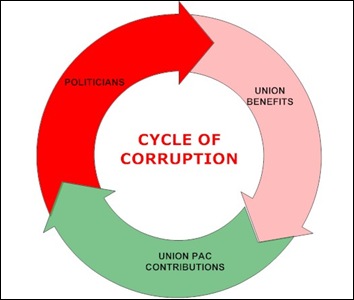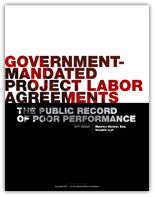Report Documents the Public Record of Poor Performance of Government-Mandated Project Labor Agreements
Proponents of anti-competitive and costly government-mandated project labor agreements (PLAs) use a variety of misleading arguments to convince public officials that granting union-signatory contractors and union labor a virtual monopoly on public construction projects through PLAs is in the public’s best interest. If public officials have not already been influenced by the cycle of PLA corruption, they might be persuaded to support these special interest handouts based on claims that private and government-mandated PLAs have a track record of delivering on-time and on-budget construction projects.

Corruption: This is How Big Labor Leverages Politics to Secure Anti-Competitive and Costly Government-Mandated Project Labor Agreements
As readers of TheTruthAboutPLAs.com know, the promise of a PLA delivering on-time, on-budget and incident-free construction is frequently broken. Arguments in support of government-mandated PLAs made by special interests that exclusively benefit from PLA monopoly schemes are easily rebutted.
Yesterday we briefly covered a new report by TheTruthAboutPLAs.com contributor Maury Baskin.
Government-Mandated Project Labor Agreements: The Public Record of Poor Performance (2011 Edition) highlights poorly performing government-mandated PLA projects documented in the media that have experienced at least one of the following issues:
• Increased Costs
• Reduced Competition
• Construction Delays
• Construction Defects
• Safety Problems
• Problems for Minorities and Women
Baskin says this report that will keep elected officials, the media and proponents of fair and free competition on public works projects informed about the poor track record of government-mandated PLA projects in their communities:
This report attempts to bring attention to as many government-mandated PLAs as possible whose actual results have been described in published media or academic reports. Those results frequently contradict PLA proponents’ claims of cost savings, avoidance of delays and/or improved performance under proposed PLAs. Rather, the published reports of PLA poor performance strongly support the assertion that government-mandated PLAs, aside from their questionable legality, are a bad bargain for taxpayers.
During the next several days, we will post each chapter from Baskin’s paper at TheTruthAboutPLAs.com.
If you are new to this issue, here is brief explanation about government-mandated PLAs from an excerpt of the introduction to Maury Baskin’s Government-Mandated Project Labor Agreements: The Public Record of Poor Performance (2011 Edition):
Government-mandated project labor agreements (PLAs) are agreements that some public entities require construction contractors and subcontractors to enter into with labor unions as a condition of being allowed to perform work on public construction projects. Government-mandated PLAs should be distinguished from voluntary, private sector PLAs, which are authorized by Sections 8(e) and 8(f) of the National Labor Relations Act solely when entered into by “employers in the construction industry” in an atmosphere free of union or government coercion.
The government-mandated PLAs described in this report are “union-only,” meaning they require all contractors and subcontractors on a covered project to sign an agreement with a labor organization, regardless of whether their employees have previously authorized any union to represent them, as a condition of performing work on a public construction project. In this sense, most government-mandated PLAs, and all of the PLAs described in this report, are “union-only.”… [snip]
Continue reading the rest of the Introduction here.












